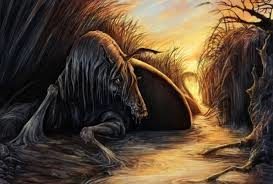
10 Feb 2021 Scottish Kelpie: The Evil One
Deep in the Scottish Isles, a myth circulates lochs, pools, and rivers. A shapeshifter taking the shape of both a horse or man, the legend of the Kelpie dates back to the sixth century and may originate from the practice of human sacrifice to the water gods.
Part horse and serpent, the Kelpie lives on both land and water and appears tame to unsuspecting victims. Children are a favorite target of the Kelpie. Tempting its prey to stroke its coat, if the beast is touched, the deathly cold skin adheres flesh to its body. The sound of the Kelpie’s tail striking water sounds like thunder. Hooves may be webbed or reversed but remain hidden in the water.
The Kelpies tempt with evil in mind. Once a victim adheres to the skin, the beast plunges its prey into deep water. Once dead, the Kelpies eat their victims, leaving behind only the liver and entrails on the shoreline as a warning to others.
Geography and environment inform belief, however. Celtic people hunted for survival. Few could swim. Many feared the water. Unexplained drownings needed answers.
The Kelpie met its own death on occasion. A mixture of Christian faith and Celtic belief summoned the beast’s demise. If captured with a halter stamped with the symbol of a cross, the Kelpie loses its power. In some cases, Kelpies appear wearing a saddle and a bridle. When a harness is removed, the Kelpie dies within a day. After Kelpie’s death, it appears as a soft mass of a jelly-fish.
 Kelpie myths exist around the world. A Nykur is a mythical beast of Faroese legend and Scandinavian folklore (Nik in English). This beast traps its victim in a barrel and drags it under the water.
Kelpie myths exist around the world. A Nykur is a mythical beast of Faroese legend and Scandinavian folklore (Nik in English). This beast traps its victim in a barrel and drags it under the water.
Scottish and Scandanavian art memorializes the Kelpie legend. Click on the link below to learn more about the evil water spirit.

